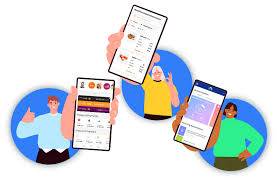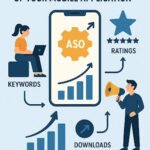Offline functionality has become the defining feature that separates professional apps from amateur attempts.
Users don’t care about your connectivity requirements when they’re in a subway tunnel, on an airplane, or in a rural area with spotty coverage. They expect apps to work, period. Mobile app development services have mastered the complex art of building applications that function seamlessly regardless of network availability, transforming offline capability from a nice-to-have feature into a competitive necessity.
The shift toward offline-first thinking represents a fundamental change in mobile development philosophy. Rather than treating offline mode as an error state to be handled, the top mobile app development companies in the US design apps that treat connectivity as an enhancement rather than a requirement. This approach creates resilient applications that users trust and depend on in any situation.
Why Offline Capabilities Matter in Mobile Apps
Importance of Access in Low or No Connectivity Areas
The connected world isn’t as connected as we pretend. Subway commuters lose signal underground. Rural areas have vast coverage gaps. International travelers face prohibitive roaming charges. Even in urban centers, building elevators and parking garages create connectivity dead zones. Apps that fail in these moments lose users permanently.
Mobile app development services understand that real-world usage rarely matches ideal conditions. They build applications that anticipate and adapt to connectivity loss rather than breaking when it occurs. This reliability transforms apps from fair-weather tools into dependable daily companions.
The business impact extends beyond user satisfaction. Apps with robust offline capabilities see higher engagement rates in emerging markets where connectivity remains inconsistent. They capture usage during commutes when users might otherwise switch to offline entertainment. They maintain functionality during network outages that would cripple purely online competitors.
Impact on User Engagement and Retention
Data tells a compelling story about offline capability’s effect on user behavior. Apps with offline functionality show 2-3x higher retention rates compared to online-only alternatives. Users open offline-capable apps more frequently, knowing they’ll work regardless of circumstances.
Session length increases dramatically when users aren’t anxious about connectivity. They engage deeply with content rather than rushing through tasks before losing signal. This relaxed usage pattern creates stronger app habits and emotional connections that drive long-term retention.
The psychological effect matters too. Users develop trust in apps that never fail them. This trust translates into higher ratings, better reviews, and powerful word-of-mouth recommendations. Mobile app development services recognize offline capability as an investment in user relationship building, not just a technical feature.
Examples of Popular Apps with Offline Features
Spotify revolutionized music streaming by allowing playlist downloads. Users no longer needed to choose between data charges and music during commutes. Netflix followed suit with downloadable shows, capturing viewers during flights and commutes. These features drove massive user growth in markets where competitors remained online-only.
Google Maps’ offline functionality saves travelers from getting lost in foreign cities without data plans. The app intelligently pre-downloads areas users frequently visit, providing navigation even when networks fail. This proactive approach to offline capability sets the standard modern users expect.
Productivity apps like Notion and Evernote sync changes made offline seamlessly when connectivity returns. Users work confidently knowing their efforts won’t disappear if the WiFi drops. This reliability makes them indispensable tools for professionals who can’t afford to lose work.
How Mobile App Development Services Implement Offline Features
Designing for Offline-First User Experience
Offline-first design starts with fundamental assumptions about connectivity. Instead of assuming connection and handling offline as an exception, development services assume offline and treat connection as an enhancement. This mindset shift influences every design decision from navigation to error messaging.
Visual indicators clearly communicate sync status without overwhelming users. Subtle icons show which content is available offline. Progress bars indicate sync progress. Timestamps reveal when data was last updated. These elements keep users informed without creating anxiety about connectivity.
Graceful degradation ensures apps remain useful even with limited offline capabilities. Features that absolutely require connectivity disable cleanly with clear explanations. Alternative offline workflows guide users to available functionality. The app never feels broken, just temporarily limited.
Managing Data Consistency and Conflict Resolution
Conflict resolution strategies must be both sophisticated and transparent. Development services implement operational transformation algorithms that merge concurrent edits intelligently. These systems track individual operations rather than final states, enabling granular conflict resolution.
Three-way merging compares offline changes against the original version and server updates. This approach identifies exactly what changed in each version, enabling intelligent automatic resolution for most conflicts. When automatic resolution isn’t possible, apps present clear options for users to choose.
Event sourcing provides another powerful approach. Instead of storing current state, apps store sequences of events that led to that state. This immutable history enables perfect reconstruction of changes and sophisticated conflict resolution. Mobile app development services use event sourcing for applications where audit trails and data integrity are paramount.
Leveraging Background Sync and Push Notifications
Background sync ensures data updates even when apps aren’t actively running. Development services implement intelligent sync schedules that balance battery life with data freshness. Sync frequency adapts based on usage patterns, network availability, and device status.
Push notifications alert users when important updates sync to their device. A document edited by a colleague syncs silently in the background, then notifies the user it’s ready for review. This combination of background sync and notifications creates an experience that feels magically connected despite offline operation.
Selective sync preserves device storage and battery life. Apps sync only data users are likely to need based on recent activity, location, and preferences. This intelligent approach prevents apps from consuming excessive resources while ensuring important content remains available.
Types of Advanced Offline Capabilities
Offline Content Access and Editing
Modern offline capabilities extend far beyond simple read-only access. Users expect to create, edit, and manipulate content offline just as they would online. Development services build sophisticated editing systems that maintain full functionality without connectivity.
Rich media editing presents particular challenges. Photo editors must work with high-resolution images offline. Video apps need to process large files locally. Audio applications require real-time processing without cloud services. Mobile app development services implement optimized algorithms and efficient storage strategies to enable these capabilities.
Collaborative editing adds another layer of complexity. Multiple users might edit the same document offline, requiring sophisticated merge strategies when they reconnect. Development services implement operational transformation or conflict-free replicated data types (CRDTs) to handle these scenarios seamlessly.
Offline Transactions and Queued Actions
Transaction queuing ensures critical actions complete even without immediate connectivity. Users can place orders, send messages, or submit forms offline. These actions queue locally and process automatically when connectivity returns. Development services implement reliable queue systems that survive app restarts and device reboots.
Optimistic UI updates make offline transactions feel immediate. The app updates as if the transaction succeeded, then reconciles with server responses later. This approach eliminates the psychological friction of waiting for network confirmation. If transactions fail, the UI gracefully reverts with clear explanations.
Transaction priority systems ensure critical actions process first when connectivity returns. Payment confirmations take precedence over analytics events. User-initiated actions process before background syncs. This intelligent prioritization ensures the most important operations complete even with brief connectivity windows.
Real-Time Updates Post Connectivity Restoration
Reconnection triggers sophisticated synchronization processes that quickly restore apps to current state. Development services implement efficient diff algorithms that identify changes during the offline period. Only modified data syncs, minimizing bandwidth usage and sync time.
Progressive sync strategies prevent overwhelming users with updates. Critical updates apply immediately while less important changes sync gradually in the background. This approach maintains app responsiveness while ensuring data currency.
Notification batching prevents alert storms when reconnecting after extended offline periods. Instead of triggering dozens of notifications for missed updates, apps intelligently summarize changes into digestible summaries. Users stay informed without feeling overwhelmed.
Challenges and Solutions in Building Offline Mobile Apps
Handling Data Conflicts and Merges
Conflict resolution remains the most complex challenge in offline app development. Development services implement multiple strategies depending on data types and business requirements. Last-write-wins works for simple overwrites. Operational transformation handles collaborative text editing. CRDTs enable automatic conflict resolution for distributed systems.
User intervention sometimes becomes necessary for complex conflicts. Development services design clear, intuitive interfaces for conflict resolution. Visual diffs show differences between versions. Preview panes demonstrate merge results. One-click options resolve common conflicts without requiring deep understanding.
Balancing Storage Limits and Performance
Device storage isn’t unlimited, and offline apps must respect these constraints. Development services implement intelligent storage management that automatically prunes old data while preserving important content. LRU (Least Recently Used) caches automatically remove stale content. User preferences determine which content receives priority for offline storage.
Performance optimization requires careful attention to database design and query patterns. Indexes accelerate common queries but consume storage space. Denormalization speeds reads but complicates updates. Mobile app development services balance these tradeoffs based on specific app requirements.
Ensuring Security of Stored Data
Offline data requires robust security measures since it resides on potentially compromised devices. Development services implement multiple layers of protection. Encryption at rest protects stored data. Secure key management prevents unauthorized access. Biometric authentication adds another security layer.
Data partitioning isolates sensitive information. Personal data might be encrypted with user-specific keys while public content remains unencrypted for performance. This granular approach balances security with usability. Remote wipe capabilities ensure lost devices don’t become security breaches.
Testing and Optimizing Offline Functionality
Simulating Network Conditions for Testing
Comprehensive testing requires simulating real-world network conditions. Development services use tools that throttle bandwidth, introduce latency, and simulate connection drops. These simulations reveal how apps behave during network transitions and extended offline periods.
Edge case testing explores extreme scenarios. What happens when sync interrupts mid-transaction? How does the app handle storage exhaustion? What occurs when time zones change during offline operation? Mobile app development services systematically test these scenarios to ensure robust operation.
Monitoring Offline Usage and User Feedback
Analytics systems must account for offline usage, collecting metrics locally and transmitting them when connectivity returns. Development services implement sophisticated analytics that track offline session duration, feature usage, and error rates. This data reveals how users actually interact with offline features.
User feedback provides qualitative insights that metrics miss. In-app feedback systems capture user frustrations and suggestions even while offline. This immediate feedback proves invaluable for identifying pain points in offline workflows.
Continuous Improvement Based on Analytics
Data-driven optimization improves offline capabilities over time. Analytics reveal which content users access most offline, informing predictive caching strategies. Error logs identify common sync failures, driving reliability improvements. Performance metrics guide optimization efforts.
A/B testing extends to offline features. Different caching strategies, sync frequencies, and conflict resolution approaches can be tested with user segments. Mobile app development services use these experiments to continuously refine offline capabilities based on actual usage patterns.
Conclusion
Mobile app development services have transformed offline functionality from a technical checkbox into a sophisticated system that enhances every aspect of the user experience. Through intelligent caching, seamless synchronization, and thoughtful design, they create apps that users trust to work anywhere, anytime.
The business value extends beyond user satisfaction. Offline capabilities expand addressable markets to include users with limited connectivity. They increase engagement by removing friction from the user experience. They differentiate apps in crowded marketplaces where reliability becomes a key selection criterion.
Looking ahead, offline capabilities will become even more critical as users expect instant, reliable access to their digital tools. The apps that succeed won’t be those that work well with perfect connectivity, but those that work perfectly regardless of connectivity.
Partnering with experienced mobile app development services ensures your app joins the ranks of those users depend on rather than merely tolerate. These services bring the technical expertise, architectural knowledge, and implementation experience necessary to build truly robust offline capabilities. The investment in proper offline functionality pays dividends in user loyalty, market reach, and competitive advantage that far exceed the development costs.
If you’re looking to stop thinking and start moving with custom mobile app development, Devsinc is a good first step. With a proven track record of delivering 3000+ projects across 5 continents, Devsinc is a professional IT service company based out of the US delivering digital excellence for more than 15 years.



